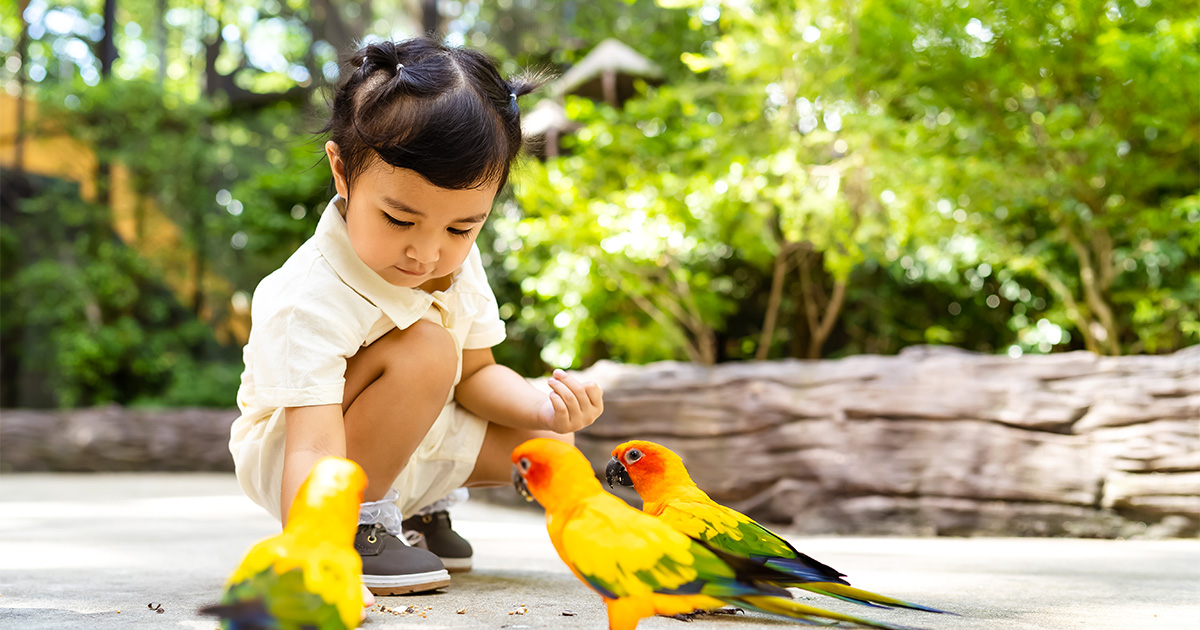- 877.684.1613
- Schedule a Tour

Interactions with animals are rich in opportunities to support a young child’s development. Animals spark curiosity and motivate children to learn more. Animals also help encourage a better understanding of important social-emotional concepts, such as care, empathy, patience, and responsibility.
Children of all ages build an appreciation for living things by observing animals and their actions. You can take it one step further by providing hands-on learning experiences. Consider spending extra time in nature or visiting a reputable animal organization.
Popular places to observe animals include:
- Nature center
- Community parks
- Animal rehabilitation center
- Educational farm
- Wildlife sanctuary
- Live wildlife cameras
- Cat cafes
- Local hiking areas
- Zoo or aquarium
Your backyard can even provide an opportunity for animal observation, allowing you to view native creatures in their natural habitat through a window or at a safe distance.
When introducing children to domestic animals, teach them how to mindfully interact with animals by moving slowly, speaking softly, and only petting animals if an adult says it is safe. Start with a one-finger touch to encourage gentle interaction with an animal, whether it is someone’s pet or in a petting zoo. Supervision is always encouraged in close, interactive spaces. Be sure to reinforce that animals in the wild should be observed but never touched for everyone’s safety.
Kid-Friendly Animal Activities by Age
Infants
Spend Time Outside: The more time you spend outdoors with your infant, the more they will naturally observe and notice. It will engage all their senses! Young infants pay close attention to sights, sounds, smells, and textures. A blanket on the ground or a portable rocker for non-mobile infants can offer a comfortable space to take in their surroundings. Talking with your infant about what you see and hear supports language development too.
Window Birdfeeder: Install a window birdfeeder to invite birds to come closer. Hanging it in a low space on a window or near a door will give your child a chance to pay attention to their movements and seed preferences. How many different types of birds visit your feeder? What color are their features? Do they make unique sounds to chatter with one another?
Toddlers/Twos
Notice Small Wildlife: Toddlers and 2-year-olds love to look at things from a different perspective. Spend time outside noticing small bugs and insects on the ground. Observe what they do, where they go, and how they interact. Are they building a home? Searching for food?
Invite Local Wildlife: Hang a birdhouse or birdfeeder in the yard. Provide a toad house or create a bug hotel to invite native wildlife into your surroundings for your child to observe. If you aren’t sure what type of bird box to install, ask a local bird group. A popular app called Merlin Bird ID by Cornell Lab helps you to identify birds based on chirps, calls, and songs.
Revisit Photos: Children at this age love to revisit previous experiences through photography. Make an album on your phone, print photos to fill a photo album, or display a digital picture frame with pictures of animals and wildlife you’ve seen on walks and visits. This invites your child to reflect, make connections, verbalize the experience, or ask questions.
Care for Animals Through Pretend Play: Play is an engaging way to introduce animal care. Collect your child’s favorite stuffed animals. Practice how to speak to, touch, and nurture them. You can create scenarios that mirror wildlife encounters or a trip to the veterinarian for treatment.
Ages 3 and Up
Set Up a Wildlife Camera: Wildlife cameras provide a fascinating way for children to observe the wildlife around your home or property. They are especially helpful in showing us the activity of nocturnal animals who only come out at night. If you live in an urban setting, look at live zoo camera feeds or take a virtual tour of a wildlife sanctuary online.
Sound Scavenger Hunt: Listen for animal sounds outside by going on a scavenger hunt to discover the source of what you’re hearing. Talk through your observations. What animals or insects might be making those sounds? Have fun making up imaginative stories about the sounds and animals.
Create an Animal Journal: Keep an animal journal for your child and invite them to draw the animals they see, including the environment. Talk about personality traits, names, and habitats. Journaling supports communication skills, writing, and building connections between ideas.
Supporting Animal Rescues and Shelters: Look for opportunities to volunteer or donate items at your local humane society or rescue organization. Some offer resources and information on animals and how to support ongoing efforts to care for animals in need of permanent homes.
Additional Activities
Want more animal-inspired ideas that promote learning through play? Click here to read an article featuring our Chief Academic Officer, Dr. Johnna Weller. She helps highlight eight fun, interactive ideas for preschoolers to fuel their love for wildlife and zoo experiences.
